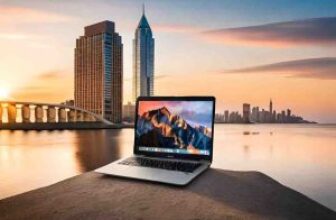[ad_1]
Apple’s latest upgraded MacBook Pro adds a wider range of chip options, a cheaper price and a new black colour option, alongside even greater performance and battery life.
The much-loved laptop now starts at £1,699 (€1,999/$1,599/A$2,699), which isn’t exactly cheap but is £450 less than its predecessor, lowering the barrier to entry significantly.
The outside of the machine has the same great-looking combination of retro and modern design of its predecessor, solidly made from aluminium with a precision worthy of the price. The port selection remains the same, including the very welcome HDMI port and full-size SD card slot.
The screen is still one of the very best on a laptop: sharp, smooth and super bright when working with or viewing HDR content. It is now 20% brighter in general use compared with its predecessor, which was noticeable when working on documents in bright winter sun.
New for 2023 is the space black colour option, which is more of a very dark grey but is about as black as you can make anodised aluminium. It looks great and repels fingerprints better than before. The new colour is limited to the mid- and high-end versions of the machine starting at £2,099 (€2,499/$1,999/A$3,499).
Specifications
-
Screen: 14.2in mini LED (3024×1964; 254 ppi) ProMotion (120Hz)
-
Processor: Apple M3, Pro or Max
-
RAM: 8, 18 or 32, or up to 128GB
-
Storage: 512GB, 1, 2, 4 or 8TB SSD
-
Operating system: macOS 14.1 Sonoma
-
Camera: 1080p FaceTime HD camera
-
Connectivity: wifi 6E, Bluetooth 5.3, 2/3x USB/Thunderbolt, HDMI 2.1, SD card, headphones
-
Dimensions: 221.2 x 312.6 x 15.5mm
-
Weight: 1.55 to 1.62kg
M3, M3 Pro and M3 Max chip choice
The big new thing is the introduction of Apple’s latest M3 family of chips, which are made at a cutting-edge scale not available to other manufacturers at the moment, boosting performance while lowering power consumption and heat.
The new entry-level 14in MacBook Pro starts with an M3, stepping up to the M3 Pro and M3 Max for greater performance needs.
The M3 chip is about 20% faster than the M2 chip used in the MacBook Air and other machines and about 40% faster than the original M1 chips from 2020. The base model can output to a single external monitor and ships with only 8GB of memory, which is likely to be perfectly fine for now but may become a limiting factor in the future. Doubling the memory costs £200 and cannot be done after the fact.
Those that require more power, additional ports and multiple external monitors can upgrade to the M3 Pro chip, which can easily handle demanding tasks and will probably be the most suitable option for those using the MacBook Pro for working purposes. The M3 Max chip sits at the top of the pile, offering a tremendous amount of performance in a laptop, which will be overkill for most, although very welcome by those looking for workstation-level power and who are willing to pay big money for it.
All of Apple’s M3 chips are at least as powerful as their Intel equivalents in PCs and offer healthy performance increases on three- to five-year-old Macs. But Apple’s biggest advantage is in power efficiency, which allows double or more the battery life of rivals and the ability to sustain peak performance when not plugged into the wall, unlike competitors.
Even the most powerful M3 Max-equipped model, as tested, will manage about 16 hours of productive office work, such as word processing, browsing, note taking and working with spreadsheets. That is more than an hour longer than last year’s model and about double that of most competitors. M3 models should last about 20 hours of similar work with the M3 Pro models somewhere in the middle.
The battery life shrinks when the chips are pushed with much more demanding tasks, but you should still get about 12 hours of photo editing or similar on a charge. It takes about 90 minutes to fully charge the battery with the included 96W adaptor, hitting 50% in about 30 minutes.
Sustainability
The MacBook Pro is made of 32% recycled materials, including aluminium, rare earth elements, tin, gold and plastic. Apple breaks down the computer’s environmental impact in its report.
The computer is generally repairable and has repair manuals available, and the battery can be replaced for £245 by Apple. The repair specialists iFixit praised the machine’s modular design but criticised Apple’s use of software locks on replacement parts that artificially limit third-party repair options, giving it a repairability score of only four out of 10. Apple offers trade-in and free recycling schemes, including for non-Apple products.
Price
The 14in MacBook Pro starts at £1,699 (€1,999/$1,599/A$2,699) for an M3 chip with 8GB of RAM and 512GB of storage. Models with the M3 Pro cost from £2,099, while M3 Max models start at £3,299.
For comparison, the MacBook Air M2 starts at £1,149, while Windows laptops roughly equivalent to the new machines, such as the Dell XPS 15, cost about £2,000, the Razer Blade 14 costs £2,499 and Microsoft’s Surface Laptop Studio 2 costs from £2,069.
Verdict
There are more options than ever for Apple’s longstanding Pro laptop this year. The lower starting price is most welcome, although it is still not cheap at £1,699 and comes with a chip that while tremendously fast, may not be powerful enough for professional work and only 8GB of memory.
That makes the base model difficult to recommend over the excellent MacBook Air for Apple users. Not so for the M3 Pro and Max models, which are yet again a remarkable combination of power and efficiency that no other manufacturer can touch. Here Apple continues to go from strength to strength.
The 14in size remains the sweet spot in laptops, which is helped by a stunning screen, best-in-class trackpad and keyboard, and a solid selection of ports. It’s not cheap but if you don’t specifically need Windows 11, it is one of the very best working laptops you can buy. And it looks pretty great in black.
Pros: choice of speedy chips, very long battery life, fantastic miniLED ProMotion screen now even brighter, plenty of ports and SD card slot, brilliant speakers, Touch ID, great keyboard and trackpad, 14in is a great size, new black colour.
Cons: no USB-A, no Face ID, no Centre Stage camera, RAM or SSD can not be upgraded after purchase, expensive, base model skimps on memory for the price.
[ad_2]






